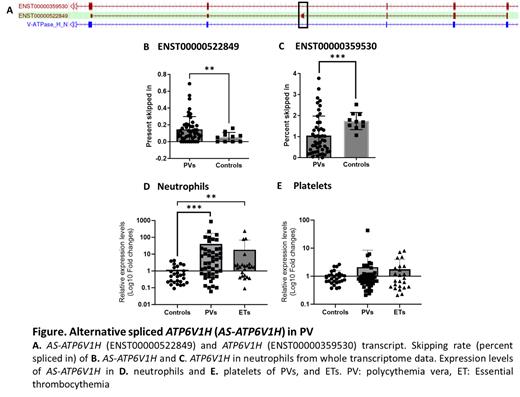Polycythemia vera (PV) and essential thrombocythemia (ET) are clonal myeloproliferative neoplasm originating from a hematopoietic stem cell. PV is characterized by increased hemoglobin; ET is characterized by high platelets due to gain-of-function mutations of the tyrosine kinase JAK2 gene, with JAK2V617F being the most common phenotype defining mutation. Thrombosis remains a major cause of PV and ET morbidity and mortality. Clonal myelopoiesis in PV is further enhanced by inflammation, contributing to PV pathogenesis. The molecular mechanisms underlying the augmented inflammation in PV remain incompletely characterized but neutrophils play a major role in inflammatory and prothrombotic complications in PV and ET.
Our whole transcriptome analysis using 46 PV neutrophils and 10 healthy controls showed that 1833 genes in PV granulocytes (adjusted p-value <0.05 and log2 fold changes >0.5) were dysregulated. Gene set enrichment analysis showed that genes involved in inflammatory response were upregulated in PV (FDR: 0.047, enrichment score: 0.578). We then interrogated in our transcriptome set differential exon usage and identified a differentially spliced exon of ATP6V1H (AS-ATP6V1H) in PV. ATP6V1H encodes ATPase H+ transporting V1 (v-ATPase) subunit H. Inhibition of v-ATPase augments the production, release, and expression of inflammatory genes. We found higher expression levels of AS-ATP6V1H (ENST00000522849) in PV neutrophil transcriptome (Figure B). The exon in the black box in Figure A is only present in AS-ATP6V1H (ENST00000522849) and its expression was higher in PV. This transcript undergoes nonsense-mediated decay, resulting in decreased ATP6V1H expression in PV (Figure C). This finding was then verified using 46 patients with PV, 24 with ET and 29 healthy controls. AS-ATP6V1H was upregulated both in PV and ET neutrophils (Figures D). However, these expression differences were not detected in platelets (Figure E).
AS-ATP6V1H transcript levels demonstrated a positive correlation with genes that are upregulated in inflammation - CXCL8, CD55, IRAK1, and IL1RAP, while showing an inverse correlation with genes downregulated in inflammation, including IGHG1, CD40LG, and TNFRSF4.These transcript levels showed a positive correlation with white blood cell (r=0.4677, p<0001) and neutrophil counts (r=0.5268, p<0001), indicating an association with heightened inflammation in PV and ET.
PV and ET patients with a history of thrombosis had higher AS-ATP6V1H transcript levels compared to those without thromboses (p=0.0427). AS-ATP6V1H transcript levels positively correlated with the levels of thrombotic genes tissue factor ( F3) and p-selectin ( SELP) and inversely correlated with an anti-thrombotic gene, KLF2 (Song, Blood Advances, 2023). These results suggest that elevated AS-ATP6V1H may also be associated with an increased risk of thrombosis.
The expression of inflammatory and thrombotic genes is influenced by hypoxia inducible factors (HIFs) (Gangaraju, Blood Advances, 2020). Reduced ATP6V1H increases HIF-1a protein levels and its transcriptional activities (Yambire, elife, 2019). We also measured the expression levels of HIF target genes in neutrophils ( EDN1, LDHA, SLC29A1, CKB, VEGFA, and SLC2A1), and these levels positively correlated with AS-ATP6V1H transcript levels.
Since inflammation is also associated with increasing JAK2V617F variant allele frequency (VAF), we also tested the correlation with JAK2V617F VAF. We observed a positive correlation of JAK2V617F VAF with AS-ATP6V1H transcript levels (r=0.74, p<0001), suggesting that hyperactive JAK2 activity might induce an mRNA splicing event in ATP6V1H.
In conclusion, our study showed a relationship between AS-ATP6V1H and inflammation in PV and ET. Through whole transcriptome analysis, we identified AS-ATP6V1H as a candidate gene, and its upregulation in PV and ET suggests its potential involvement in increased inflammation and clonal myelopoiesis. We show that AS-ATP6V1H transcript levels correlated with the expression levels of genes involved in inflammation and thrombosis and that AS-ATP6V1H may be regulated by HIFs and JAK2 activity. Further investigations should demonstrate the molecular mechanisms underlying AS-ATP6V1H's role in inflammation and thrombosis, which could lead to novel therapeutic approaches for managing PV and ET.
Disclosures
No relevant conflicts of interest to declare.


This feature is available to Subscribers Only
Sign In or Create an Account Close Modal